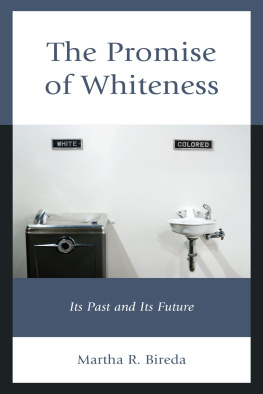Whiteness in America
Monica McDermott
polity
Copyright page
Copyright Monica McDermott 2020
The right of Monica McDermott to be identified as Author of this Work has been asserted in accordance with the UK Copyright, Designs and Patents Act 1988.
First published in 2020 by Polity Press
Polity Press
65 Bridge Street
Cambridge CB2 1UR, UK
Polity Press
101 Station Landing
Suite 300
Medford, MA 02155, USA
All rights reserved. Except for the quotation of short passages for the purpose of criticism and review, no part of this publication may be reproduced, stored in a retrieval system or transmitted, in any form or by any means, electronic, mechanical, photocopying, recording or otherwise, without the prior permission of the publisher.
ISBN-13: 978-0-7456-7218-2
ISBN-13: 978-0-7456-7219-9(pb)
A catalogue record for this book is available from the British Library.
Library of Congress Cataloging-in-Publication Data
Names: McDermott, Monica, 1971- author.
Title: Whiteness in America / Monica McDermott.
Description: Cambridge, UK ; Medford, MA : Polity, 2020. | Includes bibliographical references and index. | Summary: The invisible root of racial inequality-- Provided by publisher.
Identifiers: LCCN 2020000124 (print) | LCCN 2020000125 (ebook) | ISBN 9780745672182 (hardback) | ISBN 9780745672199 (pb) | ISBN 9781509531189 (epub)
Subjects: LCSH: Whites--Race identity--United States. | United States--Race relations--Social aspects. | Race awareness--United States. | Equality--United States.
Classification: LCC E184.A1 M3475 2020 (print) | LCC E184.A1 (ebook) | DDC 305.802973--dc23
LC record available at https://lccn.loc.gov/2020000124
LC ebook record available at https://lccn.loc.gov/2020000125
Typeset in 11 on 13pt Sabon
by Fakenham Prepress Solutions, Fakenham, Norfolk NR21 8NL
Printed and bound in Great Britain by TJ International Limited
The publisher has used its best endeavours to ensure that the URLs for external websites referred to in this book are correct and active at the time of going to press. However, the publisher has no responsibility for the websites and can make no guarantee that a site will remain live or that the content is or will remain appropriate.
Every effort has been made to trace all copyright holders, but if any have been overlooked the publisher will be pleased to include any necessary credits in any subsequent reprint or edition.
For further information on Polity, visit our website: politybooks.com
Acknowledgments
This book reflects the many conversations I have had with colleagues and students over the years. In particular, the students in my seminar on whiteness at the University of Illinois communicated the importance of understanding the manifestations of white privilege in their lives. Additionally, Helen Marrow provided useful comments, as did Jonathan Skerrett and two anonymous reviewers. Finally, I thank Rebecca Sandefur for her detailed comments, support, and encouragement.
Introduction
When Americans think about race, white is often the furthest thing from their minds. To have a race is to be black, Asian, Latina/o or American Indian. Yet whiteness colors so much of social life in the United States, from the organization and maintenance of social structures to an individuals sense of self. Why is there such a disconnect?
Before being able to answer this question, it is important to understand just what the term white means. Determining who is considered whiteor black, or American Indian, or any other racemay seem obvious. In common conversation, people are said to appear visually as though they belong to a particular race. So, for example, membership in the category white is automatic if one has light skin, straight hair, and blue eyes. However, it is not the case that the possession of a given set of physical attributes automatically designates membership of a particular racial group. The meaning of race and any corresponding physical identifiers are deeply embedded in power relations (Omi 2001). This construction of whiteness is a central part of the social construction of race itself. Race is a result of social relations, not simply a reflection of the enduring attributes of any particular group of people. Hence the category white changes its meaning and shifts its boundaries in different times and places. Sometimes it goes unnoticed by the majority group, while at other times whites are readily seen, even by themselves.
Although the privilege of whiteness has touched, in some way, every part of the globe, its manifestation in America is relatively unique. European colonialism led to an equation between race and dominance, as settler colonists from Europe oppressed and exploited non-European (and therefore non-white) residents throughout the world. One of the starkest examples of this exploitation was the slave trade. The extensive transport of slaves to the United Statescoupled with a relatively large population of European originled to the development of a society that was built upon racial violence and subordination. The genocide of indigenous populations further solidified the power of whites, who, given their numeric majority, were less threatened by a non-white revolution than were their counterparts in other countries. In America, not only is whiteness synonymous with privilege, but the mobilization and defense of whites interests have fundamentally shaped every aspect of life. Even the initial ethnic differences among European settlers slowly blurred, creating one uniform white groupat which point whiteness became increasingly associated with intelligence and a strong work ethic (Levine-Rasky 2016). As the privileges of whiteness grew greater, the desire of individuals to be included within this group became stronger.
The boundaries of whiteness have been vigorously policed by a variety of American institutions. Lpez (2006; originally published in 1996) provides a compelling account of the ways in which racial categories have been constructed by social institutions, especially the law, in the face of individual pressure for inclusion. In addition to legal measures, white has also been a subject of contestation in educational institutions, neighborhoods, social organizations, government policy, the media, and innumerable personal interactions in daily life. As Jacobson (1999) has demonstrated, the racialization of Jews is a particularly illustrative example of the ways in which whiteness is articulated and policed and, ultimately, of how malleable it is. While anti-Semitic movements and ideologies are still evident in contemporary America, Jews identification as white is assumed by all but the most extreme white supremacists. Yet there was a time less than a century ago when Jews were often considered to be non-white. One example of the discriminatory treatment that Jews received during that time comes from elite colleges and universities that had quotas designed to restrict the number of Jewish matriculates (Karabel 2005). Jewish fraternities arose in response to the exclusion of Jews from white social organizations (Sanua 2018). And restrictive covenants prevented Jews from buying homes in a number of neighborhoods throughout the country (Brooks and Rose 2013).
To many, these structural impediments to the economic and social opportunities of Jews might seem surprising. The fact that they are surprising is testament to the shifting boundaries of whiteness. But, while these boundaries may have shifted, one fact remains constant: whiteness is a definitive mark of privilege. Individuals and groups have fought bitterly for inclusion in the category of white for precisely this reason.
The whiteness that so many have striven to obtain has multiple manifestations. Perhaps the most important is the aforementioned privilege attached to this category. Ultimately, whiteness manifests itself in all circumstances as privilege, even if individuals may not view it as such. As critical race theorists note, racial stratification is ordinary, ubiquitous, and reproduced in mundane and extraordinary customs and experience (Brown 2008: 54). The privilege of whiteness is so interwoven with the normal functioning of institutions and the character of interactions that it is often noticed only in cases of rupture of the ordinary, for example when white supremacists use a racial slur. However, the power and privilege of whiteness do not require that overt racism survive; rather, advantages accrue to whites because the economic, political and social institutions of America have long been designed to secure white dominance. This may take the form of discrimination in lending, voter disenfranchisement, and a host of other ways that are not the product of individuals overt racism.







